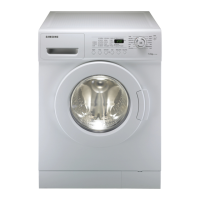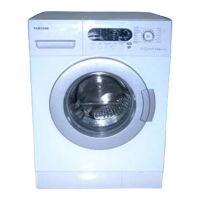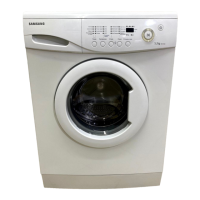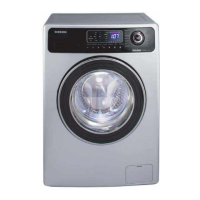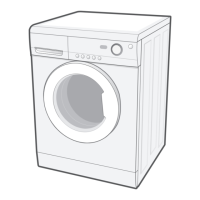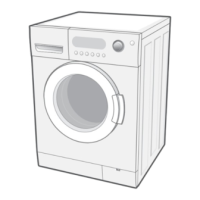Do you have a question about the Samsung WF-B105AV and is the answer not in the manual?
Important steps and precautions before operating the washing machine.
Key safety guidelines to follow during washing machine operation and maintenance.
Steps and checks for unpacking the washing machine and its components.
Diagram illustrating the main parts and components of the washing machine.
Criteria for selecting an appropriate and safe location for the washing machine.
Instructions on how to adjust the machine's feet for stability and leveling.
Guide to removing transit bolts before operation to prevent damage.
Detailed steps for connecting the water supply hose, including adapter usage.
Instructions for connecting the water inlet hose to the machine and the tap.
Different methods for positioning the drain hose for proper water discharge.
Important electrical connection guidelines, including grounding for specific regions.
Overview and explanation of the washing machine's control panel buttons and display.
Explanation of information shown on the display during the washing cycle.
How to select the pre-wash option for heavily soiled laundry.
Guide to selecting the appropriate water temperature for washing.
Instructions for adding extra rinse cycles.
How to select the desired spin speed for different fabric types.
Information on the Silver Nano feature for sterilization and antibacterial coating.
How to activate and deactivate the child lock feature on the control panel.
Using the dial to select one of the 14 available wash programs.
How to start, pause, and resume the washing cycle.
Instructions for turning the washing machine on and off.
Procedure for running the first wash cycle without any laundry.
How to correctly add detergent, fabric softener, and pre-wash.
Guide to using the automatic Fuzzy Logic system for optimal washing.
Steps to take after the washing cycle has completed.
Step-by-step guide for manually selecting wash programs, temperature, and spin.
How to program the machine to start washing at a later time.
Advice on sorting laundry, checking pockets, and fastening items before washing.
Guidance on using pre-wash for heavily soiled cotton items.
Table to help determine the correct amount of laundry for different fabric types and models.
Recommendations on selecting and using detergents, softeners, and additives.
Procedure for draining water in case of an emergency or power failure.
Steps to take if the washing machine has frozen due to low temperatures.
How to clean the outer casing and control panel.
Guide to cleaning the detergent drawer and the area where it is housed.
Instructions for cleaning the lint filter, usually indicated by an error code.
How to clean the filter in the water inlet hose, often indicated by an error code.
Common issues with the washing machine and step-by-step solutions.
Explanation of error codes displayed on the machine and their corresponding remedies.
Steps to take before calling for professional service to resolve issues.
For medium or lightly soiled cotton fabrics, bedding, napkins, underwear, towels, shirts.
For medium or lightly soiled cotton fabrics, bedding, napkins, underwear, towels, shirts.
For medium or lightly soiled blouses, shirts, made of polyester, polyamide, or blends.
For thin curtains, dresses, skirts, shirts, and blouses.
For wool items allowed for machine washing with a "pure wool" label.
Very gentle wash cycle, similar to hand washing.
For lightly soiled cotton or linen blouses, shirts, terry cloth, colored linen, jeans.
For diapers, baby bedding, napkins, etc.
For heavily soiled cotton items, bedding, towels, shirts, jeans.
For lightly soiled items of cotton or synthetics.
Very quiet wash cycle with delayed final rinse for cotton bedding, towels, shirts.
Explanation of common symbols found on garment care labels.
Critical safety guidelines regarding electrical connections and usage.
Tips for environmentally friendly operation and disposal of the washing machine.
Statement confirming compliance with European safety standards.
Detailed technical data, dimensions, power consumption, and model variations.
